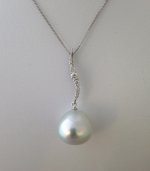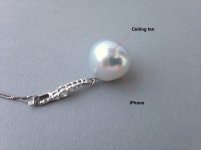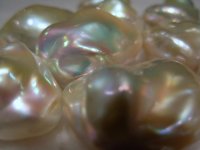Hello, I'm new here. I was wondering about orient, I've heard it's similar to the color of bubbles rainbow shine. Is that correct? I was wondering which type of pearls exhibit the most orient. Also, between freshadama and mettalic pearls which would have more orient? Last question, sorry I don't know much about pearls. But, what's is the biggest difference between freshadama and metallic pearls? Thank you so much for your help! 
You are using an out of date browser. It may not display this or other websites correctly.
You should upgrade or use an alternative browser.
You should upgrade or use an alternative browser.
Orient and freshadama/mettalic freshwater questions
- Thread starter Kpearl
- Start date
GemGeek
Pearlista
- Joined
- Sep 20, 2006
- Messages
- 9,196
Here is a good example of text book orient: https://www.pearl-guide.com/threads/bigger-than-a-walnut-paspaley-baroque-south-sea-pearl.449361/
It presents differently in round pearls. Here is a metallic example that has orient. It's easiest to spot in the white pearls. Have a look and let us know what you see. This kind of quality is not common.
 www.pearl-guide.com
www.pearl-guide.com
It presents differently in round pearls. Here is a metallic example that has orient. It's easiest to spot in the white pearls. Have a look and let us know what you see. This kind of quality is not common.
Multi-Color Metallic Pearls - Betty Sue King
If you have never met Betty Sue King, you are missing an engaging experience. Betty Sue King, affectionately titled The Pearl Goddess, is the owner of King's Ransom Pearls and she has a remarkable eye for color, quality and the unusual in pearls. She is a member of the American Gem Trade...
bluidragon
New Member
- Joined
- Jul 8, 2013
- Messages
- 144
metallic pearls.
metallic pearls.
I have seen these pearls. However, as stated before are they real cultured or manufactured like the 'cotton' peals or glass? Betty -sue did not explain a thing in the "read more" section. How are they manufactured? also, not to ask a stupid question, how large would a bead need to be in order to culture, lets say a 7mm pearl? Is the bead 6.7mm with only a small amount of nacre? I was hoping for an article. Please respond. thank you very much.
metallic pearls.
I have seen these pearls. However, as stated before are they real cultured or manufactured like the 'cotton' peals or glass? Betty -sue did not explain a thing in the "read more" section. How are they manufactured? also, not to ask a stupid question, how large would a bead need to be in order to culture, lets say a 7mm pearl? Is the bead 6.7mm with only a small amount of nacre? I was hoping for an article. Please respond. thank you very much.
Pearl Dreams
Pearl Enthusiast
- Joined
- Sep 24, 2007
- Messages
- 9,803
bluidragon,
They are cultured pearls-- with real nacre. No glass, no cotton.
Akoya pearls have a very thin layer of nacre. The very top grade pearls, Hanadama, have to have no less than .40mm of nacre (.80mm total-- .40 per each side of the spherical pearl.) Less expensive akoya pearls may have quite a bit less nacre. (And some high grade akoyas may have more than .4mm).
Let us imagine a hypothetical very high quality 7.0 mm akoya pearl with exactly .5mm of nacre per side, or 1.0mm total nacre.
Subtracting, 7.0mm pearl minus 1.0mm nacre thickness = 6.0mm bead nucleus.
These are nice round numbers, but in reality the pearl nacre is laid down by a living oyster so there will actually be variation in the size of the finished pearl due to variation in the nacre thickness. That's why a strand won't be sold as a straight 7mm strand, but as 6.5 to 7mm (also written as 6.5 x 7mm) or as 7.0-7.5mm (7.0 x 7.5mm).
With freshwater pearls, the smaller size pearls are all nacre. The large freshwaters being produced now have a bead inside. I don't know the typical nacre thickness for these large freshwater pearls-- anyone?
Tahitians by law must have at least .8mm nacre (1.6mm total) to be allowed to be exported. Pearls with thinner nacre are destroyed. South Sea pearls have very thick nacre-- 1.2mm and higher is what I have read.
They are cultured pearls-- with real nacre. No glass, no cotton.
Akoya pearls have a very thin layer of nacre. The very top grade pearls, Hanadama, have to have no less than .40mm of nacre (.80mm total-- .40 per each side of the spherical pearl.) Less expensive akoya pearls may have quite a bit less nacre. (And some high grade akoyas may have more than .4mm).
Let us imagine a hypothetical very high quality 7.0 mm akoya pearl with exactly .5mm of nacre per side, or 1.0mm total nacre.
Subtracting, 7.0mm pearl minus 1.0mm nacre thickness = 6.0mm bead nucleus.
These are nice round numbers, but in reality the pearl nacre is laid down by a living oyster so there will actually be variation in the size of the finished pearl due to variation in the nacre thickness. That's why a strand won't be sold as a straight 7mm strand, but as 6.5 to 7mm (also written as 6.5 x 7mm) or as 7.0-7.5mm (7.0 x 7.5mm).
With freshwater pearls, the smaller size pearls are all nacre. The large freshwaters being produced now have a bead inside. I don't know the typical nacre thickness for these large freshwater pearls-- anyone?
Tahitians by law must have at least .8mm nacre (1.6mm total) to be allowed to be exported. Pearls with thinner nacre are destroyed. South Sea pearls have very thick nacre-- 1.2mm and higher is what I have read.
GemGeek
Pearlista
- Joined
- Sep 20, 2006
- Messages
- 9,196
If the Betty Sue pearls have beads inside, they would still have a very thick coating of nacre to have such a lovely surface quality. Pearls with a lot of depth and orient are much more expensive than pearls without as much. Here is a better example of orient in non-baroque pearls. In this case, they are South Sea pearls.
 www.pearl-guide.com
www.pearl-guide.com
These Pearls Send a Romantic Message - Tara
The collection is XOXO and the X is immediately obvious. The O is a lustrous South Sea pearl held in its embrace. This is an excellent example of orient in a non-baroque pearl, a dream button. And here is the ring. You can get a better idea of how large they are by the side view of this...
GemGeek
Pearlista
- Joined
- Sep 20, 2006
- Messages
- 9,196
How did I miss this? It certainly could be. It looks like a rainbow overtone - more on the surface, but hard to tell. Is this with a flash? Try taking another with natural light, but put yourself between the light source (window) and the pearls. The light will come around your body and indirectly light it up. What a gorgeous pearl!
Pearl Dreams
Pearl Enthusiast
- Joined
- Sep 24, 2007
- Messages
- 9,803
They will also reflect colors around them. If you're wearing a colorful top, that may be reflected.
![1409826606B01-070192-1[1].jpg 1409826606B01-070192-1[1].jpg](https://www.pearl-guide.com/data/attachments/22/22822-3e20140577929dbf30b694e5a458e852.jpg?hash=PiAUBXeSnb)
And this 13mm Gold SS has a green orient?? Pink and green ?? lol I guess I've just never thought about it much since I tend to sell these things to people who can actually see them and I don't have to concern myself with photos and descriptions. I think to understand orient I'd need to sit down with a pile of pearls and someone who knows what they are looking at ! Wish they had that pearl class here in Australia..
Pearl Dreams
Pearl Enthusiast
- Joined
- Sep 24, 2007
- Messages
- 9,803
I would say the pair have pink and green overtones. As for the golden SSP, I do see the green overtone.
Orient is usually easier to see in pearls of irregular shape; the layers of nacre refract the light to create a rainbow effect.
The overtone is seen in the dark area in a highly lustrous pearl. Orient can be seen anywhere on the pearl.
Okay, look at the pink and blue overtones in these vintage graduated akoyas and contrast with this pair of freshwater baroque pearls that show orient.
Edit 11/15/16: I located an accidenally deleted photo of another FW baroque pearl with orient, shown below.
Orient is usually easier to see in pearls of irregular shape; the layers of nacre refract the light to create a rainbow effect.
The overtone is seen in the dark area in a highly lustrous pearl. Orient can be seen anywhere on the pearl.
Okay, look at the pink and blue overtones in these vintage graduated akoyas and contrast with this pair of freshwater baroque pearls that show orient.
Edit 11/15/16: I located an accidenally deleted photo of another FW baroque pearl with orient, shown below.
Attachments
Last edited:
Pearl Dreams
Pearl Enthusiast
- Joined
- Sep 24, 2007
- Messages
- 9,803
With my white metallic FWP that have such a strong bluish green overtone, I see a pink haze in some light, which I think is orient. I have not caught it on camera, though.
Icyjade
Member
- Joined
- Oct 6, 2014
- Messages
- 573
How did I miss this? It certainly could be. It looks like a rainbow overtone - more on the surface, but hard to tell. Is this with a flash? Try taking another with natural light, but put yourself between the light source (window) and the pearls. The light will come around your body and indirectly light it up. What a gorgeous pearl!
This was taken without flash and with me between the natural light source - exactly as you described above. The pearl usually just looks pale blue, with a hint of pink so it certainly doesn't look like this most of the time. In fact I've probably seen this effect only a couple of times on this pearl.
Some other pics, without the rainbow effect.
In light tent

Without light tent

All taken with iPhone, shaded natural light, no flash.
GemGeek
Pearlista
- Joined
- Sep 20, 2006
- Messages
- 9,196
This is orient:

Pearl Dreams' first earring has both iridescence and orient. Iridescence is that rainbow effect on the surface of a bubble or of oil floating on water. Her second photo shows orient alone (and it's an excellent example). My opinion is that orient is when you see interference colors coming from within the upper transparent/translucent layers of nacre. Light comes in and is scattered by refraction as it is reflected off the layers of nacre platelets. This can be a partial rainbow display, as it more often is in baroque pearls. However, it can be less of a color spread in round or smooth-surfaced pearls. The key is that it comes from within the nacre and the effect is not limited to the surface.
If you look at black Tahitian pearls with colorful surfaces, the body color is black (or dark gray), while the surface color is entirely overtone because the darkness of the nacre does not allow enough light refraction for orient.
If you compare your pearl to Katbran?s white pearls, you will see that the color on her pearls appears to be glowing from within. If you had them in-hand and could move them in the light, it would be easier to tell if it was orient. Which is why sometimes it?s obvious from a photo, and at other times is it devilishly difficult to discern.
A pearl with orient often displays overtone, as well. When you have seen a lot of pearls (in person) with varying degrees of orient, iridescence and overtone, judging these qualities will be a lot easier.

Pearl Dreams' first earring has both iridescence and orient. Iridescence is that rainbow effect on the surface of a bubble or of oil floating on water. Her second photo shows orient alone (and it's an excellent example). My opinion is that orient is when you see interference colors coming from within the upper transparent/translucent layers of nacre. Light comes in and is scattered by refraction as it is reflected off the layers of nacre platelets. This can be a partial rainbow display, as it more often is in baroque pearls. However, it can be less of a color spread in round or smooth-surfaced pearls. The key is that it comes from within the nacre and the effect is not limited to the surface.
If you look at black Tahitian pearls with colorful surfaces, the body color is black (or dark gray), while the surface color is entirely overtone because the darkness of the nacre does not allow enough light refraction for orient.
If you compare your pearl to Katbran?s white pearls, you will see that the color on her pearls appears to be glowing from within. If you had them in-hand and could move them in the light, it would be easier to tell if it was orient. Which is why sometimes it?s obvious from a photo, and at other times is it devilishly difficult to discern.
A pearl with orient often displays overtone, as well. When you have seen a lot of pearls (in person) with varying degrees of orient, iridescence and overtone, judging these qualities will be a lot easier.
BAS
Well-known member
- Joined
- May 25, 2013
- Messages
- 1,944
I have a request. At the next Ruckus, can someone speak about "Orient, Overtone and Iridescence"? An explanation followed by a few clear examples of each visible on a variety of pearls that we could handle and inspect would be terrific! With so many farmers/vendors present, there should be some beautiful examples available and great discussions taking place.
Pearl Dreams
Pearl Enthusiast
- Joined
- Sep 24, 2007
- Messages
- 9,803
What a great explanation, GemGeek!
Lagoon Island Pearls
Well-known member
- Joined
- Dec 8, 2009
- Messages
- 2,107
What is the difference between orient and overtone?
In science, one can often solve problems by asking the question... what would water do?
Imagine if you will, looking upon a lake on a sunny day. Like the sky, lakes appear blue even though we know water is not truly blue. This is an example of orient.
In the absence of pigment or emission of light, orient can be best described as the "orientation" of a prism between a light source and our eye. A variable factor.
We also know water is not perfectly clear. There can be multiple reasons for this. Turbidity, mineral content, algal growth etc. Excepting seasonal variations, it's basically a fixed factor. This is an example of overtone.
If we were to add ice cubes or some ripples from wind to water, there would be an effect on how our eyes perceive it. Some will reflect, some refract, some occlude. These random factors are an example of iridescence.
Aragonite (or foliated calcite) are nearly clear crystalline structures. Either may have slightly white or pale brown overtones. The protein that binds aragonite in pearls may contain pigments of any color, even though most species prevail with repetitive colorations.
Therefore, the variable color shift from aragonite crystals is described as orient, while the fixed pigmentation of the protein content is described as overtone. The random combination of both including other contaminants such as calcite, metals etc., the array of stray light is described as iridescence.
Last edited:
CathyKeshi
Well-known member
- Joined
- Mar 16, 2014
- Messages
- 4,696
Really appreciate both the "artistic" and the scientific explanations of these pearl mysteries ... special thanks to Gem Geek and to Dave 
Lagoon Island Pearls
Well-known member
- Joined
- Dec 8, 2009
- Messages
- 2,107
Really appreciate both the "artistic" and the scientific explanations of these pearl mysteries
Orient and overtone are objective terms, usually described by primary colors. Iridescence, is much more subjective, because events are represented by patterns of random or fractal behaviors. Hence we tend to apply terms when compared to known visual patterns, not necessarily chemical composition or crystalline form. For example frosty, metallic, pastel, etc.
Similar threads
- Replies
- 9
- Views
- 774
- Replies
- 2
- Views
- 343
- Replies
- 2
- Views
- 939


![1409826615B01-131131-1[1] - Copy.jpg 1409826615B01-131131-1[1] - Copy.jpg](https://www.pearl-guide.com/data/attachments/22/22821-a65a6ca603ebc1f124cbbfbd95cac086.jpg?hash=plpspgPrwf)


